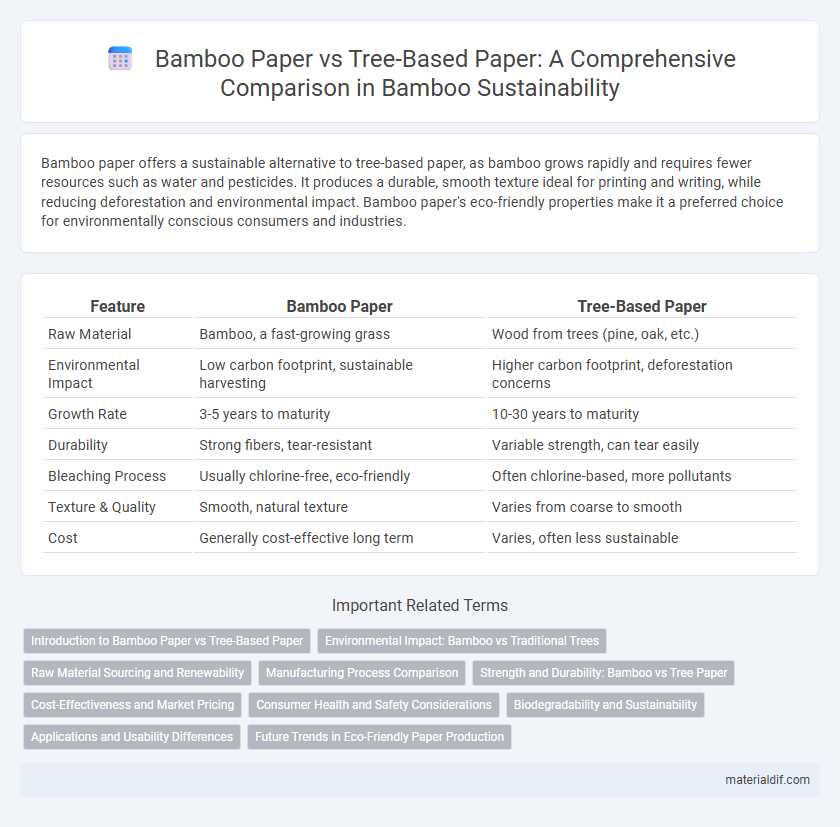Bamboo paper offers a sustainable alternative to tree-based paper, as bamboo grows rapidly and requires fewer resources such as water and pesticides. It produces a durable, smooth texture ideal for printing and writing, while reducing deforestation and environmental impact. Bamboo paper's eco-friendly properties make it a preferred choice for environmentally conscious consumers and industries.
Table of Comparison
| Feature | Bamboo Paper | Tree-Based Paper |
|---|---|---|
| Raw Material | Bamboo, a fast-growing grass | Wood from trees (pine, oak, etc.) |
| Environmental Impact | Low carbon footprint, sustainable harvesting | Higher carbon footprint, deforestation concerns |
| Growth Rate | 3-5 years to maturity | 10-30 years to maturity |
| Durability | Strong fibers, tear-resistant | Variable strength, can tear easily |
| Bleaching Process | Usually chlorine-free, eco-friendly | Often chlorine-based, more pollutants |
| Texture & Quality | Smooth, natural texture | Varies from coarse to smooth |
| Cost | Generally cost-effective long term | Varies, often less sustainable |
Introduction to Bamboo Paper vs Tree-Based Paper
Bamboo paper offers a sustainable alternative to traditional tree-based paper, as bamboo grows significantly faster and requires fewer resources such as water and pesticides. Its fibers are naturally strong and produce durable paper with a smooth texture, often outperforming tree-based paper in tear resistance and brightness. The shift to bamboo paper supports eco-friendly practices by reducing deforestation and promoting renewable resource usage.
Environmental Impact: Bamboo vs Traditional Trees
Bamboo paper production significantly reduces deforestation as bamboo regenerates up to 35% faster than traditional trees, requiring less land and resources. Unlike tree-based paper which contributes to habitat loss and higher carbon emissions, bamboo cultivation absorbs more CO2 and produces more oxygen per hectare. Furthermore, bamboo's minimal need for pesticides and fertilizers lessens soil and water pollution, making it an eco-friendlier alternative for sustainable paper manufacturing.
Raw Material Sourcing and Renewability
Bamboo paper is derived from fast-growing bamboo stalks, which can be harvested every 3 to 5 years, offering a highly renewable raw material compared to traditional tree-based paper sourced from hardwood and softwood trees that require decades to mature. Unlike tree plantations that often involve deforestation and habitat disruption, bamboo cultivation demands less water, fertilizer, and pesticides, promoting sustainable forestry practices. The rapid renewability and environmentally friendly sourcing of bamboo contribute to reduced carbon footprints and preservation of natural ecosystems in paper production.
Manufacturing Process Comparison
Bamboo paper manufacturing involves a faster growth cycle and higher yield per acre compared to tree-based paper, leading to increased sustainability and reduced deforestation. Bamboo fibers require less chemical processing due to their natural softness and antibacterial properties, minimizing environmental impact and energy consumption. In contrast, tree-based paper production demands longer growth periods and extensive chemical treatments to break down lignin, resulting in higher carbon emissions and resource use.
Strength and Durability: Bamboo vs Tree Paper
Bamboo paper exhibits superior strength and durability compared to traditional tree-based paper due to its dense fiber structure and higher cellulose content. The long, robust fibers in bamboo pulp create a paper product that resists tearing and wear, making it ideal for heavy-duty applications. Bamboo's rapid growth cycle also allows for more sustainable harvesting without compromising the quality and longevity of the paper.
Cost-Effectiveness and Market Pricing
Bamboo paper offers significant cost-effectiveness due to bamboo's rapid growth cycle, allowing for more frequent harvesting compared to traditional tree-based paper which relies on slower-growing hardwoods and softwoods. Market pricing for bamboo paper tends to be competitive, often lower than tree-based paper, as bamboo requires less water and pesticides, reducing overall production costs. Furthermore, the sustainable cultivation of bamboo aligns with increasing consumer demand for eco-friendly products, driving its market value without compromising affordability.
Consumer Health and Safety Considerations
Bamboo paper is generally considered safer for consumer health due to its natural antibacterial properties and reduced chemical usage during production compared to traditional tree-based paper, which often involves harsh bleaching agents releasing harmful toxins. Bamboo's rapid growth and minimal pesticide requirement reduce exposure to chemical residues, making it a more sustainable and hypoallergenic choice for sensitive skin. Studies indicate that bamboo paper emits fewer volatile organic compounds (VOCs), improving indoor air quality and reducing respiratory irritation risks.
Biodegradability and Sustainability
Bamboo paper demonstrates superior biodegradability compared to tree-based paper, breaking down more rapidly in natural environments due to its lower lignin content. Sustainable cultivation of bamboo involves faster growth cycles, with some species maturing in 3 to 5 years, significantly reducing deforestation impact linked to traditional tree harvesting. Bamboo's high yield per acre and minimal pesticide requirements further enhance its environmental benefits over conventional wood sources used for paper production.
Applications and Usability Differences
Bamboo paper offers superior durability and natural antibacterial properties compared to traditional tree-based paper, making it ideal for eco-friendly packaging, stationery, and hygiene products. Its fast-growing bamboo source ensures sustainable harvesting, supporting applications requiring high-volume, environmentally responsible production. Tree-based paper remains preferred for fine printing and archival purposes due to its fiber consistency and established manufacturing processes.
Future Trends in Eco-Friendly Paper Production
Bamboo paper offers a sustainable alternative to tree-based paper, as bamboo grows rapidly and requires fewer pesticides, reducing environmental impact. Future trends in eco-friendly paper production emphasize the use of bamboo for its carbon sequestration properties and biodegradability. Innovations in bamboo pulp processing are driving increased adoption in packaging and printing industries seeking greener solutions.
bamboo paper vs tree-based paper Infographic

 materialdif.com
materialdif.com